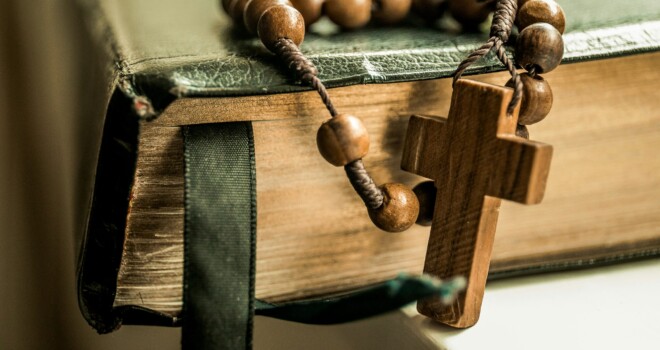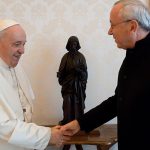According to Catholic tradition, the Virgin Mary, Mother of God, gave St. Dominic the Most Holy Rosary as a way for illiterate (and literate) lay Catholics to honor her Son by meditating on three sets of five Mysteries while reciting prayers that every Catholic knows.
The first two sets of Mysteries (the Joyful and Sorrowful) were taken from the Gospels, and the third (the Glorious) were taken not only from the Gospels, but also from Acts of the Apostles and Catholic Tradition. The Rosary was, for some, a less sophisticated way of praying a substitute for the Liturgy of the Hours that priests, nuns, and monks prayed several times a day.
In 1917, Mary visited the three children of Fatima and gave them what has become known as the “Fatima Prayer” which is focused on the mercy of God and obtaining salvation for all souls. This prayer was then added to the end of each decade.
Less than a hundred years after Fatima, Pope St. John Paul the Great gave us another set of five Mysteries (the Luminous) to help us better understand the life and ministry of our High Priest, Jesus Christ, by meditating every Thursday on five key events in the Gospel life of Christ.
Now, over twenty years after JPII’s addition to the Rosary, a bishop of a small U.S. diocese has given his flock another set of five Mysteries that helps us understand how the previous twenty fit into our understanding of Salvation History—mirroring not just the Gospels and New Testament, but the Old Testament as well. These are called: the Hopeful Mysteries.
The Most Reverend William A. Wack, CSC, bishop of the Diocese of Pensacola-Tallahassee promulgated the Hopeful Mysteries of the Most Holy Rosary on the Solemnity of the Immaculate Conception, December 8, 2024. In his letter, he indicated that after much prayer, he had granted a Nihil Obstat and Imprimatur to the Hopeful Mysteries, and he encouraged the Catholics in his diocese to pray them.
The Hopeful Mysteries are: the Creation and Fall of Man, the Great Flood, the Sacrifice of Abraham, the Passover, and the Immaculate Conception. But how do these five Mysteries help us understand Salvation History, and how do they help us to better understand the mission and ministry of Jesus Christ?
These new Mysteries are a way to contemplate and meditate on Salvation History, the narrative of God’s plan to save humanity from sin and death through the work of Jesus Christ by recalling a method to “embrace the salvation that has come to us from the first moments after the Fall of our first parents” (Bishop Wack’s press release).
Linking the Hopeful Mysteries to the Existing Ones
Lay Catholics are becoming more conscious of the unfolding of Salvation History in the Bible. We’ve likely heard how everything in the Old Testament is prefiguring the events of the New Testament, and everything in the New Testament is fulfilling the Old. But what does that really mean? And how do these new Hopeful Mysteries help us to better understand the twenty Rosary Mysteries we already have?
Salvation History began with the Creation of the World and the Fall of Man in the Garden of Eden (Genesis 1-3 and First Hopeful Mystery). From that point onward, the Almighty God wanted humankind to enter back into full communion with Him. How many times in the Bible did the Hebrew/Israelite people sin against God and go worship false gods, after which God had mercy on them and led them back to Himself, helping them along the way—usually by aiding them in battle against their pagan neighbors? Such a cycle is the history of our spiritual ancestors.
If you read the Book of Judges, you can almost become angry at the Hebrews because of how many times this scenario played out. In that Book, God even one time got tired of the repeating monotony and refused to help the Israelites win battles against their enemies (Judges 10).
God’s willingness to help His greatest creation (humankind) can be seen and felt as one meditates on how the Fall of Man is finally reversed when Jesus Christ Our Lord suffered His Passion and died on the Cross for us, to rise again to the new life He wants for us. Thus, the first Hopeful Mystery is directly linked to all the Sorrowful Mysteries and the Resurrection (the first Glorious Mystery).
Then, to put it succinctly, God got so angry with humankind for not following Him and not worshiping Him that He destroyed all living things on the Earth with a Great Flood (Genesis 6-9 and the second Hopeful Mystery). But God loves us more than we can ever know, and He wanted to bring us back into His grace. Our fallen nature is cured by our Baptism, which can only happen because of Jesus’ baptism in the Jordan River (Matthew 3, Mark 1, Luke 3, and John 1, and the first Luminous Mystery).
Our baptisms are sealed by the Holy Spirit at our Confirmations, much like the Descent of the Holy Spirit when He came upon the Apostles in the Upper Room in Jerusalem (Acts 2 and the third Glorious Mystery). Meditating on the Great Flood can help us understand Jesus’ purpose for being baptized, the purpose and meaning of our own baptisms and confirmations, and help us to better contemplate Pentecost and the reason for that event in Salvation History.
As we observe the history of Salvation, we see themes emerging. Abraham’s intended sacrifice of his beloved son Isaac (Genesis 22 and the third Hopeful Mystery) prefigures the sacrifice of Jesus Christ on Calvary (See Matthew 27, and the fifth Sorrowful Mystery) with at least thirty parallels between the two events. Among these parallels is the fact that Abraham found a substitute sacrifice in a male lamb found caught in a thorn bush, and Jesus Christ, the Lamb of God (a male lamb), who wore a crown of thorns (third Sorrowful Mystery) made from a thorn bush, and the substitute sacrifice God wants from us humans.
Furthermore, Abraham and Isaac on the mountain prefigured Jesus Christ on the mount of Golgotha. (Tradition tell us that it was in fact the same mountain!) Simply meditating on Abraham’s sacrifice and the many parallels between that event and the sacrifice of Jesus Christ—in other words, the third Hopeful Mystery and all of the Sorrowful Mysteries—can be mind altering.
The Passover event (Exodus 12 and the fourth Hopeful Mystery) was a way for the Jewish people to honor God once a year when each household would get together and eat the lamb, without the priests of the House of Aaron having to be present. Jesus at the Last Supper (See Matthew 26, a Passover meal) changed the Passover ceremony (God can change His own ceremony) to include all priests (He instituted the Sacramental priesthood there, too) who would perform the Mass as members of the priestly Order of Melchizedek, honoring God not just once a year, but every day.
The Old Covenant yearly sealed by the Passover had become a ceremony (the Mass), sealing the New Covenant of Jesus Christ. The New Covenant, followed by the Resurrection and Ascension of Jesus Christ into Heaven (Luke 24 and Acts 1, second Glorious Mystery) helped fulfill Salvation History by leading us, His followers, closer and closer to our participation in Heaven of the Wedding Supper of the Lamb (Revelation 19).
There is one event in human history that surpasses most of the other events: the Immaculate Conception of Mary in her mother’s womb. Without the Immaculate Conception (fifth Hopeful Mystery), the Son of God could never have also become the Son of Man (Annunciation, first Joyful Mystery). Jesus Christ could not dwell in a body which had participated in the Fall of Man (first Hopeful Mystery), so the Immaculate Conception was necessary for our Salvation. Father Chris Winkeljohn, one of the men who started the Hopeful Mysteries devotion, has said that he was convinced that this new set of Mysteries was something worth pursuing when he meditated on them and discovered the prime importance of the Immaculate Conception.
The Hopeful Mysteries help the faithful to explore Salvation History from the beginning of time until end of time, from the Creation and Fall of Man to the Wedding Supper of the Lamb. The new Hopeful Mysteries are one way to link the events of the Old Testament to the events of the New Testament, a way to understand how Salvation History is a simple way of seeing how major players of the Old Testament (Adam & Eve, Noah, Abraham, Moses) play a major part in the existence and perseverance of Jesus and Mary in the New Testament. Bishop Wack said in his press release that “praying these mysteries truly imparts hope for all who pray them with an open heart.”
Who Prays the Hopeful Mysteries?
The Hopeful Mysteries were an idea formulated by Tallahassee businessman Bruce Conroy. He approached Father Winkeljohn and a theologian friend, Dr. Tom Neal, about them a few years ago, and they spearheaded the drive by getting Bishop Wack involved. The bishop prayed about the new Mysteries, and on his 2024 pilgrimage walk on the Camino de Santiago, Bishop Wack prayed the Hopeful Mysteries often when praying the Rosary. Because of his developing a deep understanding of the Hopeful Mysteries and how they positively impacted his own prayer life, the bishop granted that the new Mysteries may be prayed by others in his diocese.
Although there is no way to know how many residents of the Diocese of Pensacola-Tallahassee have begun to pray these new mysteries with their daily Rosary, there have been some testimonies of success in prayer. The author prays the Hopeful Mysteries before the Joyful Mysteries on Mondays and Saturdays and finds a new peace in being able to connect the Old Testament and New Testament so easily. Additionally, the new Mysteries have led the author to a wider reading of the entire Bible—not just Genesis and the Gospels.
Some members of the lay Dominicans in Pensacola are praying these new Mysteries, and the practice is enhancing their prayer lives. For some, the Hopeful Mysteries have opened new avenues to communication with loved ones and friends.
Perhaps with time, more Catholics in places other than Bishop Wack’s diocese will see the benefits to meditating on all of Salvation History by incorporating the Hopeful Mysteries into their Rosary regimen.
Author’s Note: There is a website that has been set up to promote the Hopeful Mysteries, and anyone may contact the Diocese of Pensacola-Tallahassee for more information.
Photo by James Coleman on Unsplash














